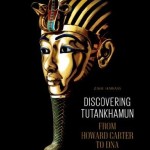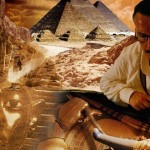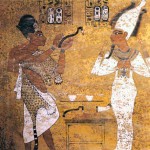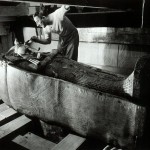
Book Review: “Discovering Tutankhamun – From Howard Carter to DNA” by Zahi Hawass
It is now some while since Zahi Hawass was finally ousted from office as Secretary General of the Supreme Council of Antiquities, following the fall of the Mubarak government in 2011; but his absolute ubiquity on TV programmes concerning ancient Egypt prior to that date (and the fact that these are repeated endlessly on various satellite/cable and terrestrial channels) means that there is little chance of any reader being unaware of his ebullient and bombastic presence. That presence is now reduced to occasional lectures about his former exploits, and adding to the series of published books that bear his name – of which this is the latest. [more…]
Edition - November, 2013

Overview of the BBC’s “Egypt – The Search for Tutankhamun”
By Andrea Byrnes and Dylan Bickerstaffe. Published on In Brief, 14th November 2013. Egypt: Series 1 – 1. The Search for Tutankhamun Part 1 of a six-part series by the BBC Director – Ferdinand Fairfax Executive Producer – Phil Dolling Series Producer – Paul Bradshaw Writer – Tony Mulholland Narrator – Andrew Sachs Described as […] [more…]

Replicating the tomb of Tutankhamun. Conservation and sustainable tourism in the Valley of the Kings
The closure of the tomb of Tutankhamun, to be replaced by an exact facsimile, has been much reported in the UK media and highlights a number of issues and raises some interesting questions. Although this is largely a discussion about the tomb of Tutankhamun, the tomb cannot be discussed in isolation and is put into the wider context of conservation issues across the royal cemeteries of the West Bank and broader globally-relevant issues of sustainable tourism. [more…]
Edition - November, 2012
TV Review of “Find My Past: Tutankhamun”
The two main themes of the show Find My Past: Tutankhamun are the discovery of the tomb of Tutankhamun (KV62), and the curiosity of descendents of three of the individuals who attended the opening of the tomb about their ancestors. [more…]
Review of Tutankhamun and the Golden Age of the Pharoahs: A Souvenir Book
Published in Egyptological, In Brief, November 14th 2012. By Kate Phizackerley There is an official companion book to the exhibition and this souvenir book, a small format volume of 64 pages. At 15.5cm by 15.2cm (about 6”) it is oddly not quite square. It is easily available for one penny (or one cent) second hand […] [more…]

Arthur Cruttenden Mace – Taking His Rightful Place, Part 2
In Part 1, we discovered how Arthur Mace took excellent advantage of a distinguished family name, overcoming the fact that wealth would not play a part in making his dreams a reality. Through education, an apprenticeship with his distinguished relative Flinders Petrie and a devotion to proper artifact conservation, Mace ensured respect from his peers. In Part 2, I will show how Mace continued to make contributions to Egyptology throughout a prolonged illness. His conservation techniques preserved artifacts spanning the Metropolitan Museum in New York to the pyramids in Lisht. Mace’s final acts of preservation, as he worked in the tomb of a previously unknown pharaoh made a name for him, although it may very well may have also contributed to his untimely passing. [more…]
Edition - April, 2012

Comparative Book Review: The Discovery of Tutankhamun’s Tomb and Tutankhamun’s Tomb: the Thrill of Discovery
Kate Phizackerley compares and contrasts two books: The Discovery of Tutankhamun’s Tomb (1976) and Tutankhamun’s Tomb: the Thrill of Discovery (2006), both published by the Metropolitan Musuem of Art and both showcasing Harry Burton’s photographs of Tutankhamun’s tomb. She identifies that both have particular strengths and weaknesses. [more…]
Libyan Desert Glass and the Breast Ornament of Tutankhamen
One of the many fabulous items in the jewellery collection from the tomb of Tutankhamen is a breast ornament. A highly decorative piece in the form of a winged scarab, dating to around 1330 BCE, it is currently on display in the Egyptian Museum in Cairo (JE 61884; Burton Photo No. P1133; Carter No. 267d). Adorned with silver, semi-precious stones and glass paste, all set into gold, the eye-catching centrepiece is a semi-translucent green scarab. Remarkable for its beauty, the pectoral has the added interest of scientific and archaeological mysteries that have yet to be completely unraveled. [more…]
AWT Conference 2011 – Excavating in the Valley of the Kings (Stephen Cross)
As described in the overview of the 2011 AWT Conference co-authored with Andrea Byrnes, the closing keynote lecture was delivered by Stephen Cross. His lecture created a buzz in the room and that has continued since Andrea Byrnes and I first posted about it on our respective blogs. In this account of his lecture, I shall present the theory as described by Cross: this is intended as reportage not as as detailed critique, although obviously a certain level of commentary is included. [more…]
 By
By